Trumpeter Swans (Cygnus buccinator) are North America’s largest waterfowl with brilliant white plumage and black bills and feet.
Once nearly extinct due to hunting and habitat loss, concerted conservation efforts have helped revive their populations. They are known for their trumpeting calls, hence the name, and monogamous nature.
On this page
Identification
Trumpeter Swans are the largest waterfowl species found in North America. Adults typically measure 4 ft 6 in to 5 ft 5 in in length and have a wingspan ranging from 6 to 10 feet. They have heavy oval-shaped bodies and long necks that they typically hold straight.
Their webbed feet are black and so are their large bills and eyes. Otherwise, adults are generally completely white. However, their heads and necks can have a rusty wash, especially during the breeding season.
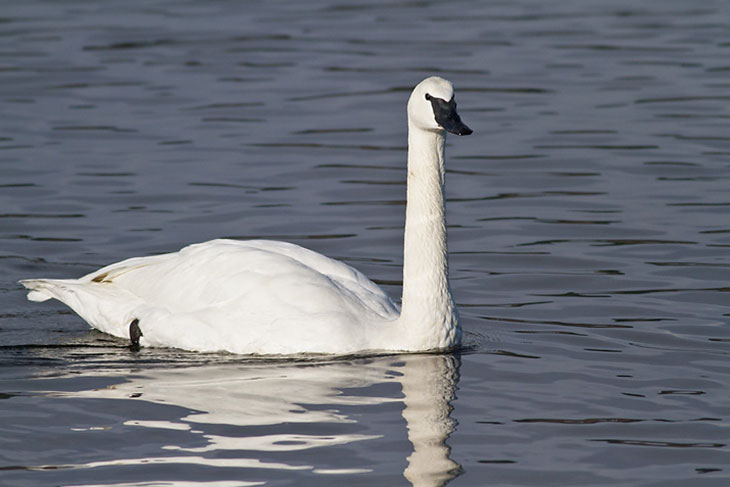
Juvenile Trumpeter Swans look a bit different than adults. They are pale gray or pale brown overall with white highlights. Their feet are grayish-pink and their black bills have a pink center.
This species should be fairly easily recognizable in flight. They often travel in pairs or family groups. Their wings are long, broad, and rounded. They fly with their head and neck outstretched in a straight line on rapid, shallow wingbeats. Their black legs extend just slightly beyond their short tails.
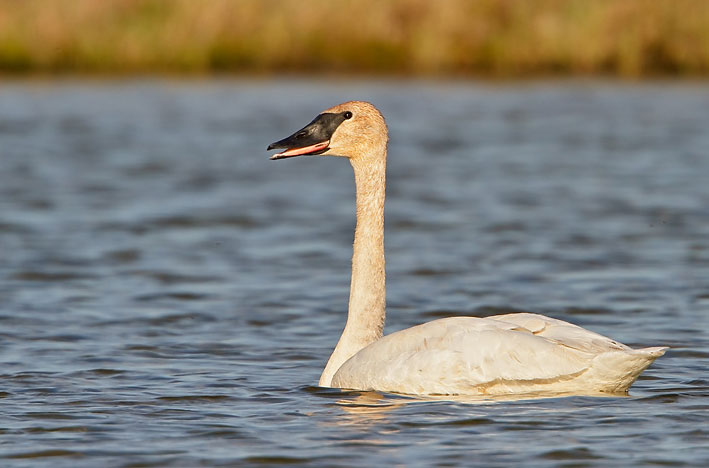
Older juveniles are starting to resemble adults
Vocalizations
Trumpeter Swans are known for their loud calls, often described as bugling or trumpeting oh-OH or ko-HOH. These calls are deep, resonant, and can carry over long distances, making them easily recognizable. The bugling calls are typically used for territorial displays, to sound alarm, and to maintain contact with their mate and offspring.
In addition to bugling calls, Trumpeter Swans also emit simpler one-noted hoo contact calls to keep in contact with each other. The calls of young swans are similar to adults but higher-pitched.
Food
The diet of Trumpeter Swans depends on their age. Cygnets are mostly carnivores whereas adults are mostly herbivores. They typically forage in bodies of water with abundant aquatic vegetation, such as shallow lakes, ponds, marshes, and slow-moving rivers. During the winter season, they may also feed on dry land.
Adults feed extensively on leaves, stems, and roots of various types of aquatic plants, including submerged vegetation, rushes, arrowleaf, eelgrass, duckweed, algae, bulrushes, wild celery, pondweeds, sedges, grasses, and aquatic tubers. However, they may also snack on the occasional aquatic insect, small fish, or fish eggs.
During winter, their diet may also include waste crops, terrestrial grasses, and berries, including ryegrass, wheatgrass, cranberries, lupine, blueberries, corn, and barley. Cygnets mainly eat aquatic insects and other small invertebrates.
While swimming, they may upend or dabble to reach submerged vegetation. They also dig into muddy substrates to extract roots and tubers.
On land, they use their bills to yank plants out of the ground or nibble on grains. When foraging underwater, they may upend with their tails up and necks extended down, finding food by touching their bills. They also pump their webbed feet to create water currents that release roots from surrounding mud.
Nesting and Eggs
Trumpeter Swans mate for life, with pairs forming at around 2-4 years of age. Courtship displays involve a series of synchronized movements, vocalizations, and posturing, including pairs raising or spreading their wings, quivering them, bobbing heads, and trumpeting. The pair stays and travels together year-round.
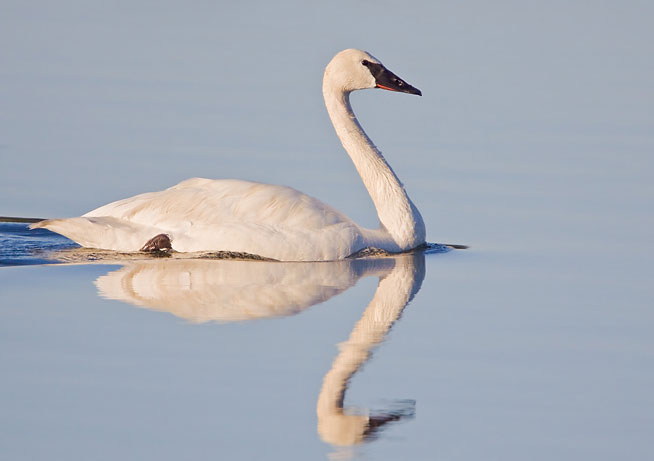
Trumpeter Swans nest in places surrounded by water but generally within 600 feet of the shore. It can be on a small island, a floating vegetation or manmade platform, or even a beaver or a muskrat den or dam. The pair may choose the nesting site years before actually starting breeding and will often use the same nest from year to year.
Both the male and female Trumpeter Swans contribute by gathering materials and building the nest, although the female may do a larger part of the actual building. The nest is a huge, roughly circular mound that can measure up to 11 feet in diameter and 3 feet high with a bowl in the middle that measures 10-16 inches in diameter and 4-8 inches deep.
It is built of various plants, including sedges, aquatic vegetation, and grasses and the nest bowl may be lined with a few feathers.
The female then lays 4-9, mostly 4-6 eggs in a clutch. Trumpeter Swan eggs are creamy to dull white and measure 4-5 inches long and 2.4-3.2 inches wide. Incubation takes 32-37 days with the female doing most of it with some help from the male.
The young leave the nest about 24 hours after hatching and feed themselves while their parents keep watch over them. They fledge 3-4 months after hatching and become independent after a year.
Current Situation
Trumpeter Swans have a slightly spotty range across northwestern and southeastern North America. They breed in Alaska, western Canada, and the northeastern United States and migrate southward for the winter. There are also some resident populations, mostly in the southern parts of their range.
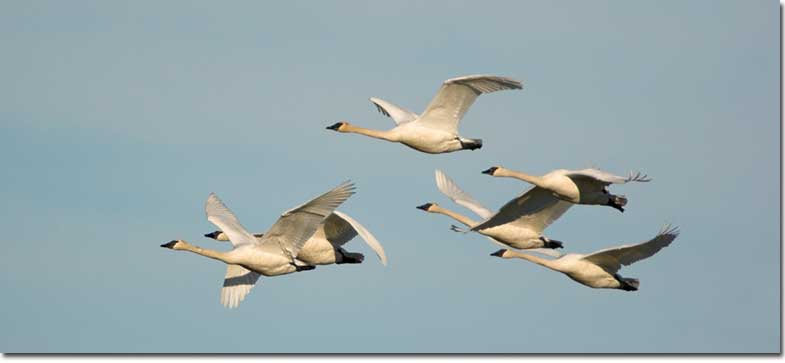
Trumpeter Swan habitat types include various wetland and riparian areas. They are most commonly found near large, shallow lakes and ponds with ample vegetation for foraging and nesting. These swans can also be found in large slow-moving rivers and marshes.
Although Trumpeter Swans nearly went extinct in the early 20th century due to hunting, they have bounced back and are now listed as a species of least concern on the IUCN Red List.
According to estimations, their population consists of around 50,000 mature individuals and is increasing. However, they still face quite a few threats in the form of illegal hunting, habitat loss and degradation, and the increase in invasive and more aggressive Mute Swans.
Facts
- Both young and adult Trumpeter Swans have a fairly high survival rate, 40-100% for the young ones and around 80-100% for the adults. Their lifespan is also high, with the oldest wild specimen on record living to at least 26 years and 2 months old and the oldest captive individual making it until 33!
- Although Trumpeter Swans have rather short legs for their size, but they are not as useless as you might think! They may walk for more than a mile in one go and they use them to incubate their eggs.
- Trumpeter Swans are both the heaviest and longest native birds in North America. They need at least a 325-feet long runway to take off.
- Trumpeter Swans nearly went extinct by the early 20th century and were only saved by aggressive conservation efforts. The birds were hunted for their skin and feathers.
Similar Species
Trumpeter Swans look similar to a few other swan and goose species and it can be quite difficult to tell which is which. Tundra Swans are nearly identical to them with Mute Swans and Snow Geese being fairly similar as well. Here is how to tell them apart.
Tundra Swan
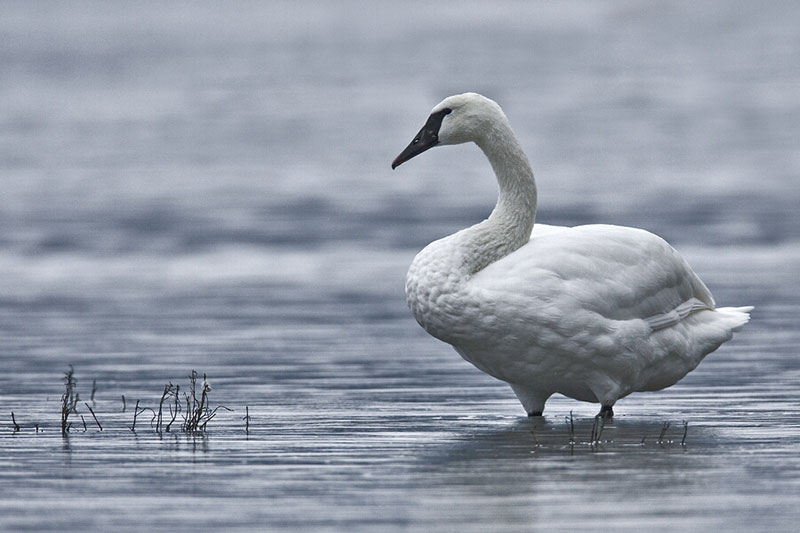
Tundra Swans breed in the Arctic along the northernmost shores of North America, including Alaska and Canada. Adults have completely white plumage and black feet and bills.
If you want to tell them apart, then look at their faces. Tundra Swans have a small yellow patch in front of their eyes, whereas in Trumpeter Swans, it is black. The bills of juvenile Tundra Swans are overall more pink whereas juvenile Trumpeters have a dark base. Overall, Tundra Swans are smaller as well.
Mute Swan
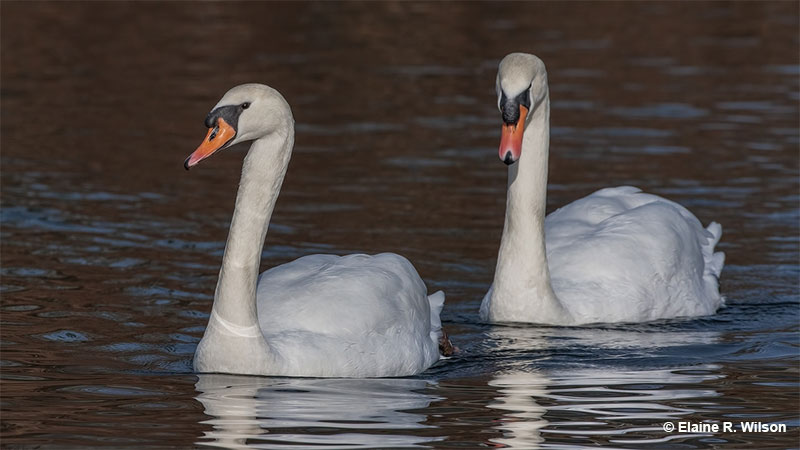
Mute Swans have year-round populations mostly in the eastern United States, especially in the Great Lakes area. Adults are pure white with black skin on their face, black feet, and bright orange bills. Juveniles are mottled white and dusky-brown with pale bills.
You can tell adults apart by their neck posture and bills. Trumpeter Swans keep their necks fairly straight and have a black bill whereas Mute Swans keep their necks curved and have an orange bill. Immature Mutes have an overall pale gray bill whereas immature Trumpeters have a darker bill.
Snow Goose
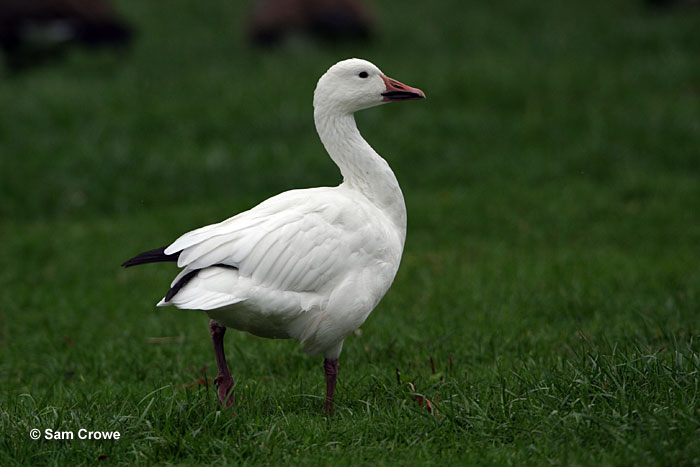
Snow Geese breed along the coasts of the northernmost areas of North America and winter in various places across the United States. They have two morphs, white and blue, but we are only focusing on the white morph. Adult white morphs are mostly snowy white overall but have black wingtips best seen while the bird is flying, but these are also visible at rest.
They have pink bills and feet. These geese are smaller than Trumpeter Swans, have smaller pink instead of black bills, pink instead of black feet, and black instead of white wingtips.
Frequently Asked Questions
How rare are Trumpeter Swans?
Trumpeter Swans, once on the brink of extinction due to habitat loss and hunting, have seen population recoveries in recent years through conservation efforts, though they may still be considered rare in certain regions.
What is special about a Trumpeter Swan?
Trumpeter Swans are the largest native birds in North America.
Are Trumpeter Swans friendly?
Trumpeter Swans are generally not aggressive but will defend their offspring.
Where do trumpeter swans go for the winter?
Trumpeter Swans winter along the west coast of Canada and parts of the eastern United States.
Where do trumpeter swans sleep at night?
Trumpeter Swans may sleep on dry ground whilst standing on one leg or they may also float with their heads tucked under their wing.
What states do Trumpeter Swans live in?
Trumpeter Swans live in Alaska and various northwestern and eastern states of the United States.

